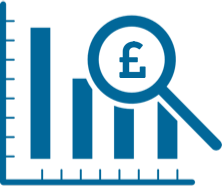How to use Liqquid's valuation model
Buying, remortgaging or selling a property is a major decision, and getting an accurate valuation is important. Valuing homes and rental properties is challenging, and there can often be wide differences between estimates provided by local agents and by valuation websites.
Liqquid has designed a valuation model from scratch that blends traditional methods with artificial intelligence, reproducing the way buyers, investors, sellers, agents, surveyors and lenders think when considering a property transaction.
We spent several years developing our model before launching it in mid-2023, and we are committed to constantly improving it. We always welcome feedback!

Get an instant estimate
- Visit the valuation page and enter a postcode for a property and select the address of the property you want to value from the dropdown list.
- Two estimates will be generated instantly, one based on what the property might be worth if in average condition, the other if in good condition. We assume that average condition properties have not been refurbished recently but are otherwise free from any major structural problems or other defects. Good condition properties are deemed to have been recently redecorated and have new or fairly recent kitchens and bathrooms.
- Our instant estimates rely on complex calculations of a large number of data points available on the property and its closest neighbours, and general pricing of similar properties in the area. Sometimes our AI-driven estimates might not have correctly identified the property type, size and number of bedrooms, which is why we suggest that everyone provides additional information using our valuation refinement tool to get a more accurate result.
- Instant estimates have a valuation confidence rating of 1 to 5, with 5 green circles indicating the highest level of confidence in the accuracy of the estimate. The ratings are based on how much information is available for us to base the valuation on, for example the number of comparable local properties that have been sold recently or which are currently for sale, or how recently the property itself was sold.
Refine a valuation estimate
- Instant estimates use publicly-available information and AI to generate results, but can be made much more accurate if more data is provided by someone that lives in or knows the property well. It takes just a few minutes to add the required information by clicking on the "edit your valuation" link below the instant estimates.
- Refining a valuation involves filling out an online questionnaire to describe the property type, internal space, features, improvements made, extensions added and other useful characteristics for evaluating the property.
- Once the questionnaire has been filled (the property type, floor area and number of beds are particularly important, as well as any major refurbishments), the valuation estimate will be recalculated.
- Refined valuations will take into consideration all condition descriptions, improvements and extensions made but will cap the updated valuation at the the level of the most expensive properties in the local area. Refined price caps help ensure that the pricing of modified properties reflects the likely upper limits of what buyers have historically been prepared to pay to live nearby.


Get estimates for the rest of a postcode
- You can get estimates for the rest of a postcode once you have registered with Liqquid. Each instant estimation has a button that provides instant estimates for every other property in the same postcode as long as we have sufficient data.
- Postcode valuation lists can take 2 to 3 minutes to generate in some cases as they involve a very large number of calculations using the latest property details and pricing information. We are working on speeding this process up so please bear with us.
- Each postcode valuation list displays a table of the average valuations for each property type in the postcode (detached, semi-detached, terraced, flat) along with a bar chart illustrating the number of properties sold each year for the last 10 years, broken down by property type.
- Postcode valuation lists also display information on the property type and the most recent sold price from HM Land Registry if there has been a sale transaction since 1995.
Create a list or portfolio
- Lists and portfolios can be created to monitor groups of properties that are of interest or that are owned by the same person or company.
- Lists are simply a group of properties added to a list name, such as "2 bed flats in Leicester" or "Rentals in Cornwall". Lists can be created whenever a property save icon is clicked, and viewed in the Watchlist.
- Portfolios are similar to lists but add the estimated valuation of each property, as well as a total valuation for the portfolio. Valuation estimates in each portfolio can be refined individually to improve accuracy. Portfolios are useful particularly for landlords and potential investors.
